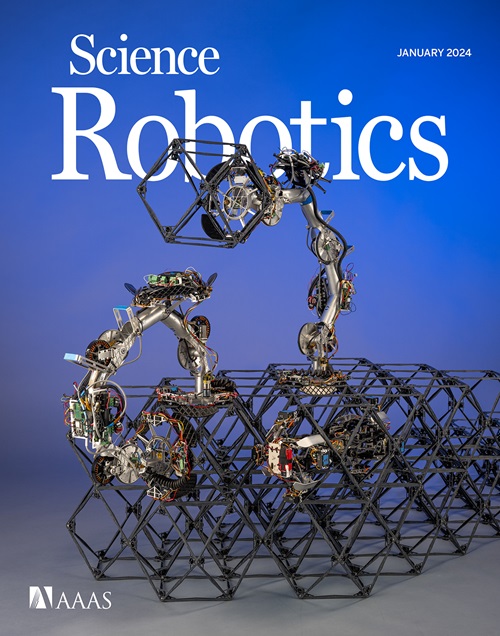In situ foliar augmentation of multiple species for optical phenotyping and bioengineering using soft robotics
IF 27.5
1区 计算机科学
Q1 ROBOTICS
引用次数: 0
Abstract
Precision agriculture aims to increase crop yield while reducing the use of harmful chemicals, such as pesticides and excess fertilizer, using minimal, tailored interventions. However, these strategies are limited by factors such as sensor quality, which typically relies on visual plant expression, and the manual, destructive nature of many nonvisual measurement methods, including the Scholander pressure bomb. By automating more intimate interactions with foliage in vivo, it would be possible to inject chemical and biological probes that reveal more phenotypes—such as water stress in response to varying environmental conditions and visible gene expression to measure the success of gene engineering applications. To address this, we developed a soft robotic leaf gripper and stamping-injection method to improve foliar delivery of nanoscale synthetic and biological probes. This allows for nondestructive, in situ, multispecies applications. We used two probes: Agrobacterium tumefaciens carrying the RUBY gene as a reporter system for plant transformation and nanoparticle hydrogels for measuring leaf water potential (ψ). Our hourglass-shaped design enabled the gripper to exert higher forces with reduced radial expansion compared with conventional designs, achieving an injection success rate above 91%. Studies on sunflower (Helianthus annuus L.) and cotton (Gossypium hirsutum L.) showed that our method achieved an average 12-fold increase in infiltration areas, with substantially less leaf damage—3.6% in sunflower and none in cotton—compared with the needle-free syringe method. Enabling long periods of successful in vivo phenotyping on both species after precise and safe foliar delivery underscores the potential of the leaf gripper for robotic plant bioengineering.

利用软机器人技术进行多物种的原位叶面扩增,用于光学表型分析和生物工程
精准农业的目标是提高作物产量,同时减少有害化学物质的使用,如农药和过量肥料,使用最少的定制干预措施。然而,这些策略受到诸如传感器质量等因素的限制,传感器质量通常依赖于植物的视觉表达,以及许多非视觉测量方法(包括Scholander压力炸弹)的手动破坏性。通过自动化与植物在体内更密切的相互作用,将有可能注入化学和生物探针,揭示更多的表型,例如对不同环境条件的水分胁迫反应和可见基因表达,以衡量基因工程应用的成功。为了解决这个问题,我们开发了一种柔性机器人叶片抓取器和冲压注射方法,以改善纳米级合成和生物探针的叶片递送。这允许非破坏性,原位,多物种应用。我们使用了两种探针:携带RUBY基因的农杆菌(Agrobacterium tumefaciens)作为植物转化的报告系统,纳米颗粒水凝胶用于测量叶片水势(ψ)。与传统设计相比,沙漏形状的设计使夹持器能够施加更大的力,同时减少径向膨胀,实现了91%以上的注入成功率。对向日葵(Helianthus annuus L.)和棉花(Gossypium hirsutum L.)进行的研究表明,与无针注射器法相比,该方法的渗透面积平均增加了12倍,对叶片的伤害显著减少(向日葵为3.6%,棉花为零)。在精确和安全的叶片输送后,能够在两个物种上长时间成功地进行体内表型分析,这凸显了叶片抓取器在机器人植物生物工程中的潜力。
本文章由计算机程序翻译,如有差异,请以英文原文为准。
求助全文
约1分钟内获得全文
求助全文
来源期刊

Science Robotics
Mathematics-Control and Optimization
CiteScore
30.60
自引率
2.80%
发文量
83
期刊介绍:
Science Robotics publishes original, peer-reviewed, science- or engineering-based research articles that advance the field of robotics. The journal also features editor-commissioned Reviews. An international team of academic editors holds Science Robotics articles to the same high-quality standard that is the hallmark of the Science family of journals.
Sub-topics include: actuators, advanced materials, artificial Intelligence, autonomous vehicles, bio-inspired design, exoskeletons, fabrication, field robotics, human-robot interaction, humanoids, industrial robotics, kinematics, machine learning, material science, medical technology, motion planning and control, micro- and nano-robotics, multi-robot control, sensors, service robotics, social and ethical issues, soft robotics, and space, planetary and undersea exploration.
 求助内容:
求助内容: 应助结果提醒方式:
应助结果提醒方式:


